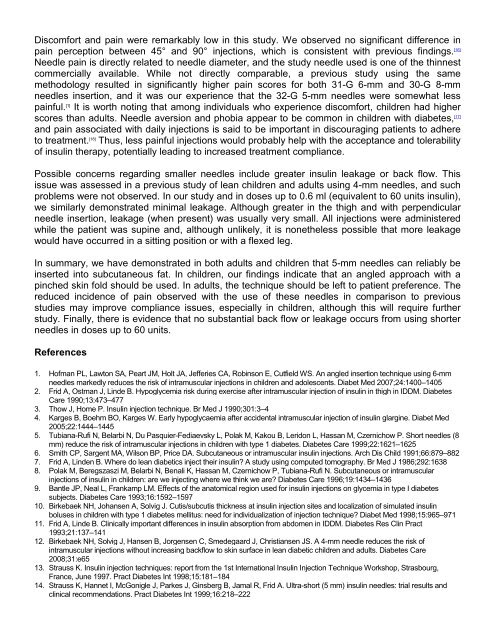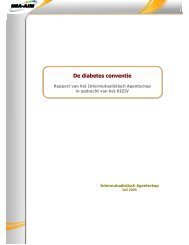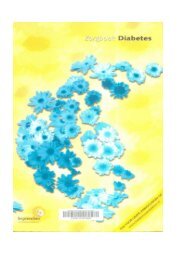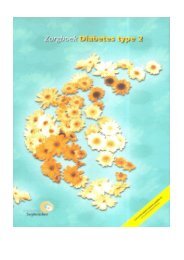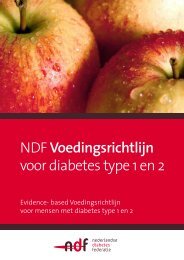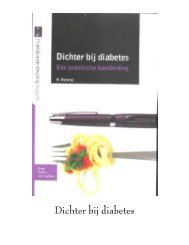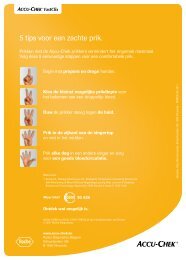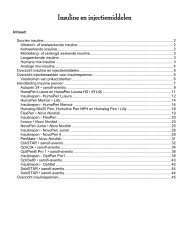Ideal Injection Techniques When Using 5-mm Needles in ... - Bvvde
Ideal Injection Techniques When Using 5-mm Needles in ... - Bvvde
Ideal Injection Techniques When Using 5-mm Needles in ... - Bvvde
You also want an ePaper? Increase the reach of your titles
YUMPU automatically turns print PDFs into web optimized ePapers that Google loves.
Discomfort and pa<strong>in</strong> were remarkably low <strong>in</strong> this study. We observed no significant difference <strong>in</strong><br />
pa<strong>in</strong> perception between 45° and 90° <strong>in</strong>jections, which is consistent with previous f<strong>in</strong>d<strong>in</strong>gs. [16]<br />
Needle pa<strong>in</strong> is directly related to needle diameter, and the study needle used is one of the th<strong>in</strong>nest<br />
co<strong>mm</strong>ercially available. While not directly comparable, a previous study us<strong>in</strong>g the same<br />
methodology resulted <strong>in</strong> significantly higher pa<strong>in</strong> scores for both 31-G 6-<strong>mm</strong> and 30-G 8-<strong>mm</strong><br />
needles <strong>in</strong>sertion, and it was our experience that the 32-G 5-<strong>mm</strong> needles were somewhat less<br />
pa<strong>in</strong>ful. [1] It is worth not<strong>in</strong>g that among <strong>in</strong>dividuals who experience discomfort, children had higher<br />
scores than adults. Needle aversion and phobia appear to be co<strong>mm</strong>on <strong>in</strong> children with diabetes, [17]<br />
and pa<strong>in</strong> associated with daily <strong>in</strong>jections is said to be important <strong>in</strong> discourag<strong>in</strong>g patients to adhere<br />
to treatment. [18] Thus, less pa<strong>in</strong>ful <strong>in</strong>jections would probably help with the acceptance and tolerability<br />
of <strong>in</strong>sul<strong>in</strong> therapy, potentially lead<strong>in</strong>g to <strong>in</strong>creased treatment compliance.<br />
Possible concerns regard<strong>in</strong>g smaller needles <strong>in</strong>clude greater <strong>in</strong>sul<strong>in</strong> leakage or back flow. This<br />
issue was assessed <strong>in</strong> a previous study of lean children and adults us<strong>in</strong>g 4-<strong>mm</strong> needles, and such<br />
problems were not observed. In our study and <strong>in</strong> doses up to 0.6 ml (equivalent to 60 units <strong>in</strong>sul<strong>in</strong>),<br />
we similarly demonstrated m<strong>in</strong>imal leakage. Although greater <strong>in</strong> the thigh and with perpendicular<br />
needle <strong>in</strong>sertion, leakage (when present) was usually very small. All <strong>in</strong>jections were adm<strong>in</strong>istered<br />
while the patient was sup<strong>in</strong>e and, although unlikely, it is nonetheless possible that more leakage<br />
would have occurred <strong>in</strong> a sitt<strong>in</strong>g position or with a flexed leg.<br />
In su<strong>mm</strong>ary, we have demonstrated <strong>in</strong> both adults and children that 5-<strong>mm</strong> needles can reliably be<br />
<strong>in</strong>serted <strong>in</strong>to subcutaneous fat. In children, our f<strong>in</strong>d<strong>in</strong>gs <strong>in</strong>dicate that an angled approach with a<br />
p<strong>in</strong>ched sk<strong>in</strong> fold should be used. In adults, the technique should be left to patient preference. The<br />
reduced <strong>in</strong>cidence of pa<strong>in</strong> observed with the use of these needles <strong>in</strong> comparison to previous<br />
studies may improve compliance issues, especially <strong>in</strong> children, although this will require further<br />
study. F<strong>in</strong>ally, there is evidence that no substantial back flow or leakage occurs from us<strong>in</strong>g shorter<br />
needles <strong>in</strong> doses up to 60 units.<br />
References<br />
1. Hofman PL, Lawton SA, Peart JM, Holt JA, Jefferies CA, Rob<strong>in</strong>son E, Cutfield WS. An angled <strong>in</strong>sertion technique us<strong>in</strong>g 6-<strong>mm</strong><br />
needles markedly reduces the risk of <strong>in</strong>tramuscular <strong>in</strong>jections <strong>in</strong> children and adolescents. Diabet Med 2007;24:1400–1405<br />
2. Frid A, Ostman J, L<strong>in</strong>de B. Hypoglycemia risk dur<strong>in</strong>g exercise after <strong>in</strong>tramuscular <strong>in</strong>jection of <strong>in</strong>sul<strong>in</strong> <strong>in</strong> thigh <strong>in</strong> IDDM. Diabetes<br />
Care 1990;13:473–477<br />
3. Thow J, Home P. Insul<strong>in</strong> <strong>in</strong>jection technique. Br Med J 1990;301:3–4<br />
4. Karges B, Boehm BO, Karges W. Early hypoglycaemia after accidental <strong>in</strong>tramuscular <strong>in</strong>jection of <strong>in</strong>sul<strong>in</strong> glarg<strong>in</strong>e. Diabet Med<br />
2005;22:1444–1445<br />
5. Tubiana-Rufi N, Belarbi N, Du Pasquier-Fediaevsky L, Polak M, Kakou B, Leridon L, Hassan M, Czernichow P. Short needles (8<br />
<strong>mm</strong>) reduce the risk of <strong>in</strong>tramuscular <strong>in</strong>jections <strong>in</strong> children with type 1 diabetes. Diabetes Care 1999;22:1621–1625<br />
6. Smith CP, Sargent MA, Wilson BP, Price DA. Subcutaneous or <strong>in</strong>tramuscular <strong>in</strong>sul<strong>in</strong> <strong>in</strong>jections. Arch Dis Child 1991;66:879–882<br />
7. Frid A, L<strong>in</strong>den B. Where do lean diabetics <strong>in</strong>ject their <strong>in</strong>sul<strong>in</strong>? A study us<strong>in</strong>g computed tomography. Br Med J 1986;292:1638<br />
8. Polak M, Beregszaszi M, Belarbi N, Benali K, Hassan M, Czernichow P, Tubiana-Rufi N. Subcutaneous or <strong>in</strong>tramuscular<br />
<strong>in</strong>jections of <strong>in</strong>sul<strong>in</strong> <strong>in</strong> children: are we <strong>in</strong>ject<strong>in</strong>g where we th<strong>in</strong>k we are? Diabetes Care 1996;19:1434–1436<br />
9. Bantle JP, Neal L, Frankamp LM. Effects of the anatomical region used for <strong>in</strong>sul<strong>in</strong> <strong>in</strong>jections on glycemia <strong>in</strong> type I diabetes<br />
subjects. Diabetes Care 1993;16:1592–1597<br />
10. Birkebaek NH, Johansen A, Solvig J. Cutis/subcutis thickness at <strong>in</strong>sul<strong>in</strong> <strong>in</strong>jection sites and localization of simulated <strong>in</strong>sul<strong>in</strong><br />
boluses <strong>in</strong> children with type 1 diabetes mellitus: need for <strong>in</strong>dividualization of <strong>in</strong>jection technique? Diabet Med 1998;15:965–971<br />
11. Frid A, L<strong>in</strong>de B. Cl<strong>in</strong>ically important differences <strong>in</strong> <strong>in</strong>sul<strong>in</strong> absorption from abdomen <strong>in</strong> IDDM. Diabetes Res Cl<strong>in</strong> Pract<br />
1993;21:137–141<br />
12. Birkebaek NH, Solvig J, Hansen B, Jorgensen C, Smedegaard J, Christiansen JS. A 4-<strong>mm</strong> needle reduces the risk of<br />
<strong>in</strong>tramuscular <strong>in</strong>jections without <strong>in</strong>creas<strong>in</strong>g backflow to sk<strong>in</strong> surface <strong>in</strong> lean diabetic children and adults. Diabetes Care<br />
2008;31:e65<br />
13. Strauss K. Insul<strong>in</strong> <strong>in</strong>jection techniques: report from the 1st International Insul<strong>in</strong> <strong>Injection</strong> Technique Workshop, Strasbourg,<br />
France, June 1997. Pract Diabetes Int 1998;15:181–184<br />
14. Strauss K, Hannet I, McGonigle J, Parkes J, G<strong>in</strong>sberg B, Jamal R, Frid A. Ultra-short (5 <strong>mm</strong>) <strong>in</strong>sul<strong>in</strong> needles: trial results and<br />
cl<strong>in</strong>ical reco<strong>mm</strong>endations. Pract Diabetes Int 1999;16:218–222


